Ceiling Lifts: 2025 Ultimate Ceiling Lift Guide
Ceiling lifts are designed to maximize space and minimize the human hands needed to transfer a person from place to place, such as from their bed to the bathroom or a chair. They provide ergonomic lifting, transferring a person quickly and safely. With a ceiling lift, the user can access two or more places, even if space is limited.

With a sling or body support combined with a ceiling track system that takes the user from room to room, an overhead lift system makes it much easier to accomplish activities of daily living. They are practical for both private and professional users, as safe patient handling protects the user or patient as well as their caregiver. The ceiling lift system helps the user overcome barriers while leaving open floor space, and also helps reduce attendant injuries while providing patient care.
In this guide, we’ll share everything you need to know about ceiling lifts! Feel free to continue reading, or use the table of contents below to jump to a specific topic or section you’re interested in learning about.
Ceiling Lift Guide Table of Contents:
Benefits of a Ceiling Lift
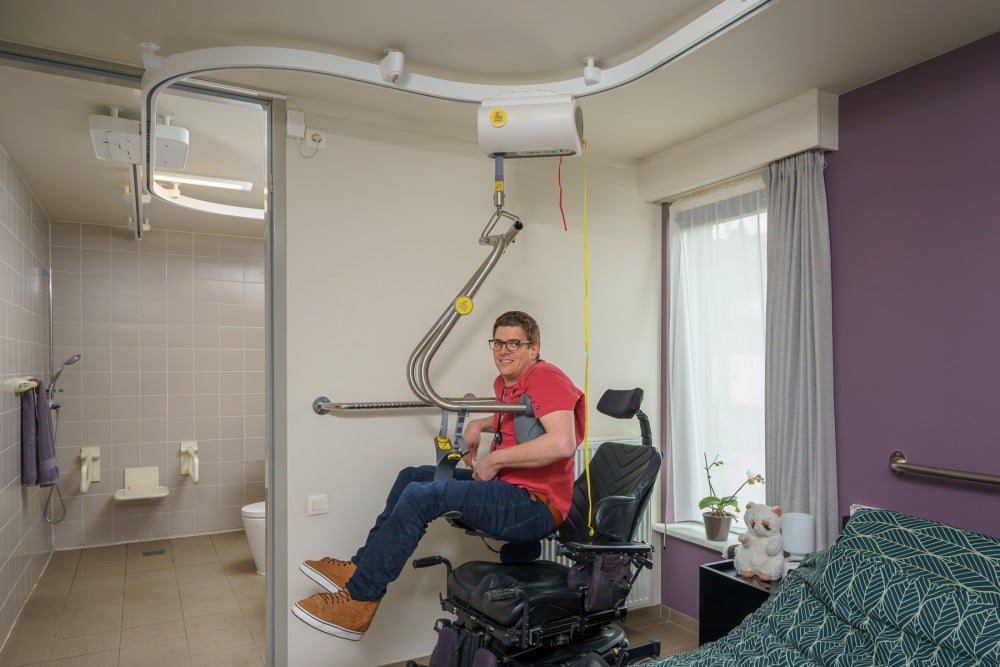
Ceiling lifts significantly improve the lives of those with mobility issues who otherwise couldn’t move from one area of their home to another without assistance. Individuals benefiting from a ceiling lift may be non-ambulatory, developmentally disabled, and/or medically fragile, with a history or diagnosis of strokes, spinal cord injury, spinal muscular atrophy, brain injury, muscular dystrophy, ALS (amyotrophic lateral sclerosis disease), multiple sclerosis, or any long-term disability.
A ceiling lift is clinically appropriate for all of these conditions. These tools allow many medically dependent people to continue living at home when a care facility would otherwise be required. Caregivers also benefit from using body support systems with ceiling lifts, because they take the human hands out of lifting, saving caregivers’ backs!
The Top 7 Benefits of a Ceiling Lift:
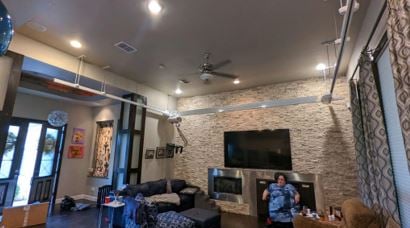
- Solving multiple mobility issues – bed transfers, toileting, & showering – with one safer solution for transfers for caregivers and users
- Consistency in transfers
- Saving floor space
- The lift can move with you to a new home
- Quick installation (vs. construction)
- Independence for the user
- Time savings and peace of mind for caregivers
Types of Ceiling Lifts
There are three basic types of ceiling lifts. While each type of ceiling lift can help with safer and more independent transfers, one may be recommended over the others depending on the transfer needs of the individual and caregiver, types of transfers required, available space, and other factors.
- Fixed Ceiling Lifts: Permanently installed in one location.
- Portable Ceiling Lifts: Can be moved between different tracks or rooms.
- Track Systems: Includes straight, curved, and room-covering tracks to suit.

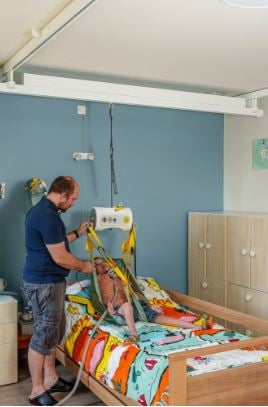
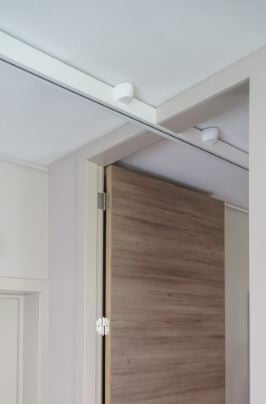
Ceiling Lift Features & Components
Every individual and environment varies, so your solution should be customized to meet your needs. Options you may consider include:
To decide whether a solution is ideal for your environment, consider the lift’s durability, maneuverability, battery life, versatility, lifting range, sturdiness, safety, practicality, and ease of operation. You should also consider the individual’s abilities—do they have reduced muscle tone? Are they able to get up from a sitting position?

Ceiling track systems provide transfers from one place to another, and customized track designs can provide single or multiple transfer locations. When combined with curves, switches, and traverse tracks, ceiling lifts can accomplish transfers wherever needed: the bed, toilet, bathtub, shower, change table, or recliner. The user can access several rooms throughout the home and reach different locations with just one system, making it ideal for small spaces.
Specialists design ceiling lift systems for new construction as well as existing spaces, blending practicality and simplicity with functionality to achieve the best solution for each client. Tracks can be attached to the ceiling or hung from brackets mounted to each wall. In either case, scale drawings are provided to architects, designers, builders, and homeowners to ensure that the solution will work before it is installed.
Options to consider include:
Turntable, multiple points: The electric points and turntable allow for a ceiling motor to travel in different directions and rooms. Maybe you want to go from a bedroom off the main hallway to the tub or shower in a corner of the bathroom, and the toilet that is not in line. Both areas can be reached with the push of a button, changing the direction of the track just like on the railroad. Even in small areas, multiple directions can be accessed.
Traverse track: When it is necessary to lift from any point in a room, the traverse track system is ideal. This system consists of two fixed ceiling or wall mounted parallel rails and one fortified traverse rail that moves back and forth on the parallel rails. Total room coverage is achieved from one ceiling track system.
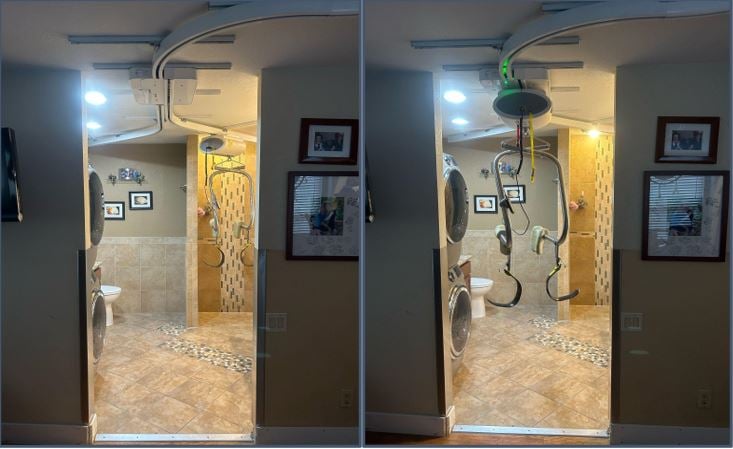
The motor and rail systems make it possible to access all areas and the automatic stop allows the lift to stop at any desired position. For safety, there is a mechanical emergency down feature that can be enabled by the user. Let the motor help you with the strain of lifting and lowering, and then easily transport the person laterally along the track system once they are suspended. A wireless remote control version is also available. Transfers to bed, bath or toilet have never been easier.
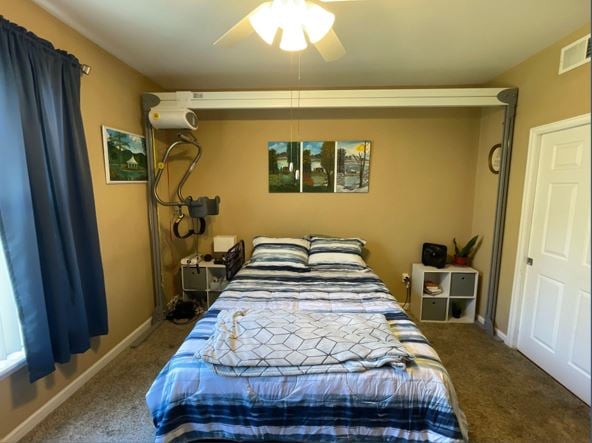
Body Support System – You’re in Good Hands!
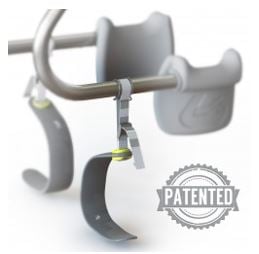
For independent usage, a ceiling motor with a SureHands® Body Support provides a safer way to transfer between a bed and wheelchair. You decide when you get up or go to sleep! No shoulder strength is needed with the Body Support, as it lifts the same way a mother lifts her child: embracing, comforting, and providing a feeling of security. The Body Support goes on easily and provides that same feeling while leaving essential parts of the body accessible for care.
The Body Support system may be contraindicated for users who are unable to control their head or who lack of a hip socket (someone that has not ambulated), as well as those with floppy neck (using a mega head support), osteoporosis, skin issues (pressure sore/wounds), no proprioception to orient self once lifted off the floor, and feet aren't touching the ground, fulcrum hip dysplasia, Muscular Dystrophy (MD) or Cerebral Palsy (CP) kids that don’t have hip sockets.
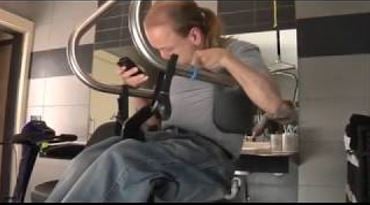
Supports can be placed inside or outside the thighs based on user preference. Contour thigh supports are available for hypotonic distribution and low tone in the hip. The straps tighten or loosen based on the user’s core strength, and a safety/utility strap is available for those with low tone or core strength.
Posturing is also improved from the caregiver’s standpoint, as it is easy to help the user get back into the chair.
8 Benefits of the Body Support System:
- Allows for safer transfers from wheelchair to bed, bath, shower, or toilet.
- Lifts and transfers quickly, easily, and safely.
- Can be used independently or with an attendant.
- Ideal for aquatic, hippo, and ambulation therapies.
- Leaves the seat entirely free—convenient for toilet use.
- Comfortable and ergonomic sitting position.
- Patented thigh supports designed for extra comfort.
- Hygienic and easy to clean.

Ceiling Lift Slings
There is an ideal sling available for every circumstance with a caregiver. Those who are unable to control their head or who are otherwise contraindicated for use of the Body Support will benefit from the wide range of slings. Ceiling lift and other types of transfer lift slings are available in mesh, solid fabric, parachute fabric, and PVC, and most are machine washable and tumble dryer safe. They are available in various sizes and models to fit different types of lift systems. They can provide smooth transfers in both laying and sitting positions, and are available with or without head support.
7 Most Common Sling Types:
1. Standard/Contour Sling – for universal use
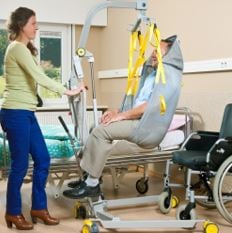
The most common and supportive sling is the standard/contour sling, which fully supports the body and includes a cut-out for toileting. Patients can be easily positioned in the sling, and safely removed from it when they are placed into a wheelchair. A four-point spreader bar creates extra room and allows the user to sit or lay more comfortably than with a straight two-point spreader bar.
The sling’s padded legs feel soft, offer ideal support, and also prevent the leg flaps from binding or bunching up. The standard/contour sling is available with or without a crescent-shaped head support. However, when more targeted head support is required, the six-strap models are a great solution. The standard/contour sling is available in solid fabric and mesh, and a version without padding can be used when the sling must remain underneath the user.
2. DayLite™ Sling – ideal for sensitive skin
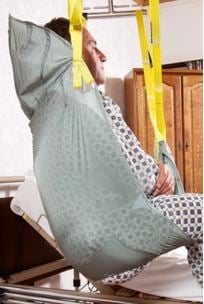
Based on the standard/contour sling, the DayLite™ sling is made of a parachute-quality nylon which is very strong, but with a smooth, soft texture to help prevent skin irritations. This exclusive thin fabric allows the sling to comfortably remain under the user, as it actually wicks moisture away.
Sometimes referred to as a toileting sling, this model is specially designed to make toileting possible while in the security of the sling. It’s so easy to put on that sometimes it can even be used independently. The large cut-out area behind the thighs and up the lower back allows access to clothing so that the belt or waistband can be loosened and the user’s pants can be removed while he or she is in the sling. A wide velcro belt is closed around the user’s abdomen for extra safety and support. A version with head support is also available.
3. Thorax Hygiene Sling
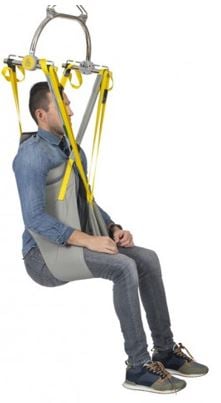
The Thorax hygiene sling offers more support than a regular hygiene sling. An area behind the thighs and up the lower back remains more free compared to a standard sling, but less so than a hygiene sling. The sling also includes a self-adjusting system around the waist for even better support.
4. Bathing Sling – PVC for quick drying in wet areas
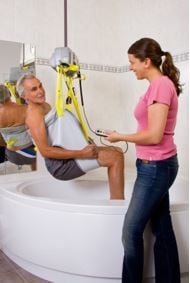
The shape of the bathing sling is identical to that of the hygiene sling; only the material is different. The bathing sling is made of maintenance-friendly, latex-free, slip-proof, synthetic material that can be easily wiped dry. The bathing sling can be used dry as an alternative to the hygiene sling. The bottom and lower back remain free thanks to the large opening, ideal for intimate care.
5. Amputee Sling – for people with an amputation above the knee
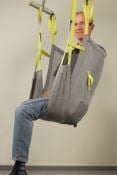
Amputee slings are designed to be comfortable and safe while perfectly balancing the body.
For people with a single amputation above the knee, a standard sling in mesh without head support with extended leg straps can be used.
For people with a double amputation above the knee, a rectangular sling without head support, with or without a toilet opening can be used. This sling is available in different materials: mesh, solid fabric, or parachute-quality nylon fabric.
6. Walking Harness – for gait training and ambulation
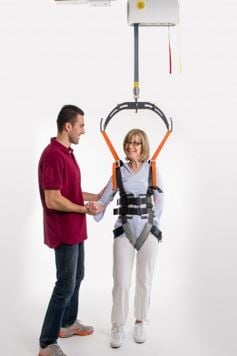
The ability to adjust this harness with numerous belts and buckles makes it an ideal tool for properly supporting the shoulders, stomach, chest, and legs during gait training and ambulation. The safety strap further supports the user if fatigue is a problem during training.
7. Bariatric Sling – a suitable solution for the bariatric market
Bariatric slings are adapted to handle a higher weight load for larger users. These types of slings can be customized to create a personal design that works safely for the individual
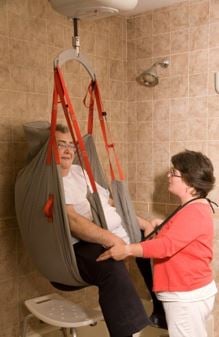
How to Choose the Best Ceiling Lift
Choosing a ceiling lift involves several considerations to ensure it meets your needs and is installed correctly. Here are 8 steps that will help you choose the best ceiling lift:
1. What Are the User’s Needs?
- Determine the specific needs of the user, including their weight, mobility level, and the types of transfers required.
- Consider the environments where the lift will be used (e.g., bedroom, bathroom, living area).
2. What Type of Ceiling Lift Is Best?
- Portable Ceiling Lifts: These can be moved between different tracking systems in various rooms.
- Fixed Ceiling Lifts: These are permanently installed in one location and offer higher weight capacities and more stability.
- Manual vs. Powered: Manual lifts require physical effort to move the lift along the track, while powered lifts use a motor.
3. What Weight Capacity Is Needed?
- Ensure the lift has an adequate weight capacity for the user.
- Most lifts range from 200 to 600 pounds, but bariatric models can handle higher weights.
4. What Track System Is Needed?
- Straight Tracks: Ideal for linear transfers from one point to another.
- Curved Tracks: Useful for navigating around corners and obstacles.
- X-Y (H) Systems: Allow for complete room coverage, enabling the lift to move in both horizontal and vertical directions.
5. Which Sling Is Best?
- Choose the right sling for the user, considering factors like comfort, support, and ease of use.
- Various types of slings are available, including full-body slings, hygiene slings, and specialized slings for different needs. These come in various shapes, sizes, and materials.
6. Which Safety Features Are Needed?
- Look for safety features such as emergency stop buttons, battery backup, and anti-fall mechanisms.
- Ensure the lift complies with relevant safety standards and regulations.
7. Is the Lift System Practical?
- Consider how easy the lift is to operate, maintain, and charge (for powered lifts).
- Look for intuitive controls and clear instructions.
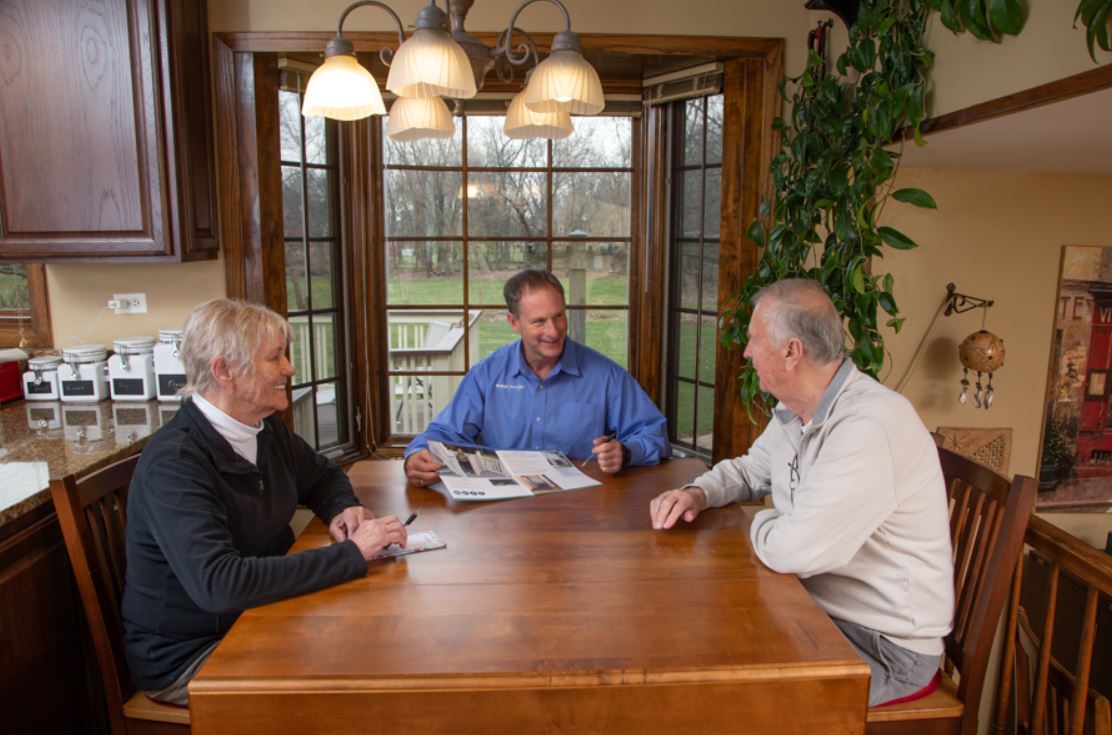
8. What Do the Professionals Say?
- Have a healthcare professional or occupational therapist along with a home access professional assess the user and recommend suitable options.
- Consult with a home access professional installer to evaluate the structural integrity of your ceiling and determine the best track system configuration.
Ceiling Lift Pricing
The pricing of a ceiling lift can vary widely depending on the type, features, and installation requirements. By carefully considering these factors, you can choose a ceiling lift that meets your needs and ensures safe and efficient transfers.
How Much Does a Ceiling Lift Cost?
Actual costs can vary, so it’s essential to get specific quotes for your project. The example of budgetary costs below includes all the equipment specified. Additional costs will be incurred for moving ceiling fans or lights, and upgrading remotes, in-ceiling supports, vaulted ceilings, and travel. These estimates are for guidance only, enabling you to get a better understanding of how much a ceiling lift would cost for your needs.
| Ceiling Lift Type | Budgetary Cost |
|---|---|
| Caregiver Lifts | |
| Basic Portable Caregiver Lift: Portable motor, basic sling, 10' of rail, installed with unistrut to ceiling. Perfect for a bedroom or a bathroom. | $7,000–$9,000 + options |
| Basic Fixed Motor Caregiver Lift: Fixed motor, basic sling, 10' of rail, installed with unistrut to ceiling. Perfect for a bedroom or bathroom. | $7,000–$9,000 + options |
| Multiple Room System with Portable Motor Caregiver Lift: 2 installations of track in 2 separate rooms, basic sling, installed with unistrut to ceiling. Portable motor can be moved from one rail in the bedroom to another rail in the bathroom, living room, or anywhere. | $8,000–$14,000 |
| Independent Lifts | |
| Basic Independent Lift: including Surehands Body Support, wired remote, 10' rail installed in a single room with unistrut to ceiling. | $9,000–$11,000 |
| Multiple Room Independent Lift: with continuous track through each room. Includes Surehands Body Support, wired remote, 10-20' of rail installed in 2 rooms with a continuous track from room to room. Remodeling or removing door headers is not included. | $12,000–$18,000 |
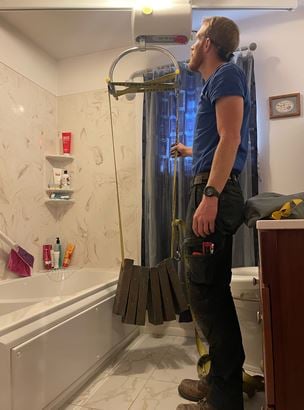
Ceiling Lift Installation
Installation of a ceiling lift involves mounting the track system to the ceiling structure, ensuring it can support the weight capacity required. It is recommended to have a professional installer handle the setup to ensure safety and compliance with regulations.
At Lifeway Mobility, our team of technicians are fully trained and certified to professionally install ceiling lifts for safer and independent transfers throughout a home.
Watch our Los Angeles team install a fixed ceiling lift system in a home in CA:
Service & Maintenance
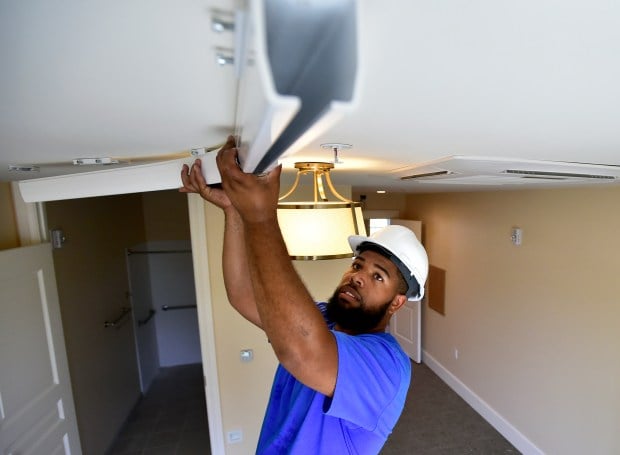
Lifeway Mobility offers service after installation of a ceiling lift as needed. It’s also suggested that regular maintenance be done to ensure optimal performance of a ceiling lift. Some of the maintenance can be done on your own, but an annual maintenance inspection is best done by one of our professionally trained technicians. Regular maintenance typically includes:
- Cleaning: Dusting and wiping down the unit to keep it clean and free of dust & debris.
- Testing: Periodic testing can help ensure proper functioning of the lifting component.
- Inspecting the track & motor: Check for any signs of wear and tear.
- Professional Servicing: Annual inspections are recommended.
Ceiling Lift FAQs
What is a ceiling lift?
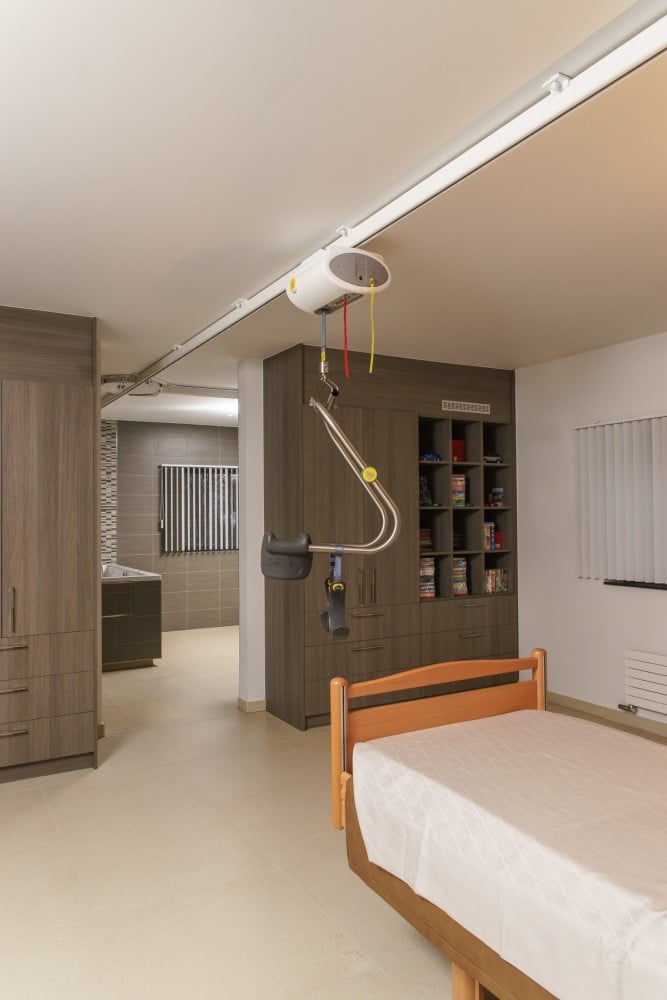
A ceiling lift is a mechanical device designed to assist in the transfer and movement of individuals with limited mobility. It consists of a motor unit mounted on a track system installed on the ceiling, which allows for safe and efficient lifting and transferring of patients.
How does a ceiling lift work?
A ceiling lift uses a motorized mechanism to raise and lower a sling, harness or body support system that supports the patient. The motor moves along a track system installed on the ceiling, enabling the caregiver to move the patient to different locations within the room or between rooms.
What are the benefits of using a ceiling lift?
- Increased Safety: Reduces the risk of injury for both patients and caregivers.
- Ease of Use: Simplifies the process of transferring patients.
- Improved Mobility: Facilitates movement for individuals with severe mobility restrictions.
- Space Saving: No floor space is required, unlike mobile lifts.
Who can benefit from a ceiling lift?
- Patients with Limited Mobility: Those who have difficulty moving independently.
- Caregivers: Helps in reducing physical strain during patient transfers.
- Healthcare Facilities: Ensures safe and efficient patient handling.
Are ceiling lifts covered by insurance?
Coverage varies depending on the insurance provider and policy. It’s advisable to check with your insurance company to determine if ceiling lifts are covered under your insurance plan.
Can ceiling lifts be customized?
Yes, ceiling lifts can be customized to fit the specific needs of the user and the layout of the space. Options include different track lengths, motor types, and sling styles.
Download Brochures
Download our SureHands catalog for more information specific to a certain type of ceiling or transfer lift:
If you have any additional questions or would like to set up a free consultation for a ceiling lift, please don’t hesitate to contact us. We hope you found this guide to be beneficial in helping you learn about ceiling lifts and other types of patient transfer lifts.
